Language and Cross-Cultural Perceptions of Deception
Analytical study on detecting lies in verbal behavior and cross-cultural detection of deception.
66 Pages19094 Words160 Views
Added on 2023-06-10
About This Document
This dissertation proposal analyzes and compares truthful and deceptive discourse of a selected number of native English-speaking British and non-native English-speaking Nigerians. The discourse done in a one-on-one interview allows for spontaneous answers. These reflect on each respondent and features questions about individuals.
Language and Cross-Cultural Perceptions of Deception
Analytical study on detecting lies in verbal behavior and cross-cultural detection of deception.
Added on 2023-06-10
ShareRelated Documents
Number 874274
Dissertation Proposal
Dissertation Proposal
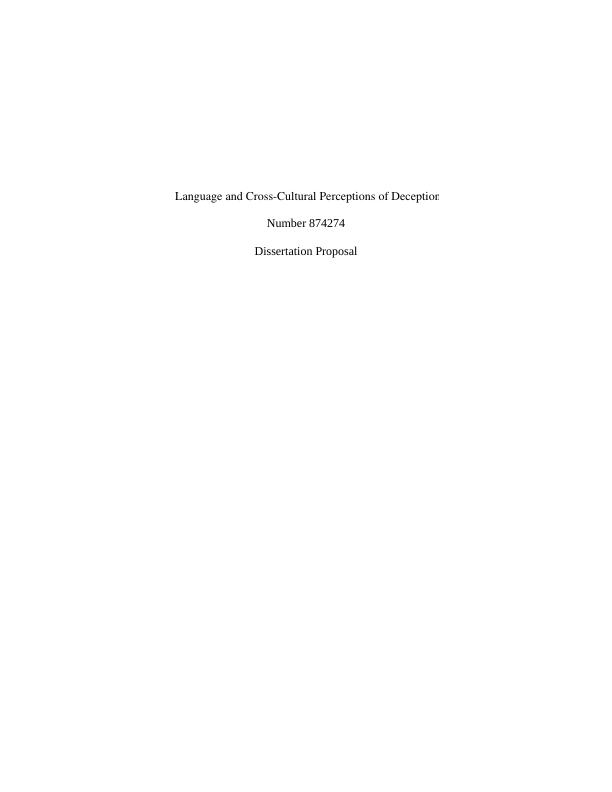
Table of Contents
CHAPTER ONE.....................................................................................................................7
THE LANGUAGE OF DECEPTION: A CROSS-CULTURAL ANALYSIS........................7
1.1 INTRODUCTION........................................................................................................7
CHAPTER TWO..................................................................................................................10
2.1 Introduction.................................................................................................................10
2.2 LIE, DECEIT AND DECEPTION..............................................................................10
2.3 Prevalent theories of deception and language............................................................12
2.3.1 Scientific Content Analysis (SCAN)...................................................................12
2.3.2 Interpersonal Deception Theory (IDT)................................................................13
2.4 LINGUISTIC FEATURES AS CHARACTERISTICS OF DECEPTION...............14
3.0 CHAPTER THREE.........................................................................................................22
RESEARCH DESIGN..........................................................................................................22
3.1 Introduction.................................................................................................................22
3.2 Part 1: Face to Face Interview.....................................................................................23
3.2.1 Interviews.............................................................................................................23
3.2.2 Participants...........................................................................................................23
3.2.3 Stimuli and method..............................................................................................24
3.2.4 Data analysis........................................................................................................24
3.3 Part 2...........................................................................................................................25
3.3.1 Online Survey.......................................................................................................25
3.3.2 Participant............................................................................................................26
3.3.3 Stimuli and method..............................................................................................26
3.3.4 Data analysis........................................................................................................27
4.0 CHAPTER FOUR...........................................................................................................28
RESULTS..............................................................................................................................28
4.1 Results for Question 1: Linguistic Features of Deception..........................................28
4.1.1 English Linguistic Features of Deception............................................................29
4.1.2 Nigerian’s linguistic Features of Deception.........................................................30
4.2 Question 2: The English and Nigerian Baselines........................................................30
4.3 Results for Question 3: Accuracy and Confidence Levels..........................................33
4.4 Results for Question 4: Cultural Bias.........................................................................34
4.5 Summary.....................................................................................................................35
CHAPTER FIVE...................................................................................................................36
Discussion.............................................................................................................................36
5.1 Introduction.................................................................................................................36
5.1.2 Methodology Pros and Cons................................................................................37
5.1.3 Model framework and analysis............................................................................39
CHAPTER ONE.....................................................................................................................7
THE LANGUAGE OF DECEPTION: A CROSS-CULTURAL ANALYSIS........................7
1.1 INTRODUCTION........................................................................................................7
CHAPTER TWO..................................................................................................................10
2.1 Introduction.................................................................................................................10
2.2 LIE, DECEIT AND DECEPTION..............................................................................10
2.3 Prevalent theories of deception and language............................................................12
2.3.1 Scientific Content Analysis (SCAN)...................................................................12
2.3.2 Interpersonal Deception Theory (IDT)................................................................13
2.4 LINGUISTIC FEATURES AS CHARACTERISTICS OF DECEPTION...............14
3.0 CHAPTER THREE.........................................................................................................22
RESEARCH DESIGN..........................................................................................................22
3.1 Introduction.................................................................................................................22
3.2 Part 1: Face to Face Interview.....................................................................................23
3.2.1 Interviews.............................................................................................................23
3.2.2 Participants...........................................................................................................23
3.2.3 Stimuli and method..............................................................................................24
3.2.4 Data analysis........................................................................................................24
3.3 Part 2...........................................................................................................................25
3.3.1 Online Survey.......................................................................................................25
3.3.2 Participant............................................................................................................26
3.3.3 Stimuli and method..............................................................................................26
3.3.4 Data analysis........................................................................................................27
4.0 CHAPTER FOUR...........................................................................................................28
RESULTS..............................................................................................................................28
4.1 Results for Question 1: Linguistic Features of Deception..........................................28
4.1.1 English Linguistic Features of Deception............................................................29
4.1.2 Nigerian’s linguistic Features of Deception.........................................................30
4.2 Question 2: The English and Nigerian Baselines........................................................30
4.3 Results for Question 3: Accuracy and Confidence Levels..........................................33
4.4 Results for Question 4: Cultural Bias.........................................................................34
4.5 Summary.....................................................................................................................35
CHAPTER FIVE...................................................................................................................36
Discussion.............................................................................................................................36
5.1 Introduction.................................................................................................................36
5.1.2 Methodology Pros and Cons................................................................................37
5.1.3 Model framework and analysis............................................................................39

5.2 Discussion of Research Question 1 Results....................................................................40
5.3 Discussion of Research Question 2 Results....................................................................42
5.4 Discussion of Research Question 3 Results................................................................45
5.5 Discussion of Research Question 4 Results................................................................48
5.6 Implications.................................................................................................................50
Research Question 1......................................................................................................50
Research Question 2......................................................................................................52
Research Question 3......................................................................................................53
Research Question 4......................................................................................................55
5.7 Limitations..................................................................................................................57
5.8 Suggestions for Further Research...............................................................................58
5.9 Conclusion..................................................................................................................59
References.............................................................................................................................61
5.3 Discussion of Research Question 2 Results....................................................................42
5.4 Discussion of Research Question 3 Results................................................................45
5.5 Discussion of Research Question 4 Results................................................................48
5.6 Implications.................................................................................................................50
Research Question 1......................................................................................................50
Research Question 2......................................................................................................52
Research Question 3......................................................................................................53
Research Question 4......................................................................................................55
5.7 Limitations..................................................................................................................57
5.8 Suggestions for Further Research...............................................................................58
5.9 Conclusion..................................................................................................................59
References.............................................................................................................................61

CHAPTER ONE
THE LANGUAGE OF DECEPTION: A CROSS CULTURAL ANALYSIS
1.1 INTRODUCTION
Is there really a way to detect lies? For decades, an extensive body of research in forensic
psychology has identified systematic differences between truthful and deceptive accounts of
witnesses or alleged victims of crimes in both children and adults (Landry & Brigham, 1992;
Steller, 1989; Joffe, 1992). One conclusive research work is Ekman (2003) asserts that one can
more accurately detect whether someone is lying or not- based on the expressions or micro
expressions on the speaker’s face. Brinke et al avers that deception most times consists of an
utterance together with unfelt emotions or in other words, masking the real emotions. However,
linguistic researchers have canalized the attention to the study of verbal clues of deception, that
is, analytical approaches to lie detection through verbal behavior.
A handful of linguistic research has attempted to provide evidence of several verbal cues
or linguistic features as characteristic of lying. For example, Porter & Yuille (1996) observe that
in the 1960 interrogations of the notorious S.S. officer, Eichmann, his interrogator, Avner Less,
observed that a specific verbal clue to deception was crucial in directing the investigation. Less
(1983) stated: 'As time went on, I noticed that each time Eichmarm said 'Never! Never! Never,
Herr Hauptmann[' or At no time! At no time!' he was lying. That was always a cue for me to ask
my colleagues to search for additional material with which to probe the sensitive spot" (p. xxi).
While this approach might have proven helpful to the investigator, several studies have provided
conflicting results on the matter (Todd, 1977; Ebesu & Miller, 1994, Zhou et al, 2004; Hauch,
2012). The differences in the results have been traced to context. Therefore, disharmony in the
conflicting results presents the first problem addressed in this study.
In addition, Ekman’s (2003) has further asserted that the micro expressions that usually
accompany the lies are made and interpreted the same way universally. Several scholars (Izard,
1994; Ekman, 1994, 2003, 2009) equally adopt this proposition. Hence, forensic linguists have
THE LANGUAGE OF DECEPTION: A CROSS CULTURAL ANALYSIS
1.1 INTRODUCTION
Is there really a way to detect lies? For decades, an extensive body of research in forensic
psychology has identified systematic differences between truthful and deceptive accounts of
witnesses or alleged victims of crimes in both children and adults (Landry & Brigham, 1992;
Steller, 1989; Joffe, 1992). One conclusive research work is Ekman (2003) asserts that one can
more accurately detect whether someone is lying or not- based on the expressions or micro
expressions on the speaker’s face. Brinke et al avers that deception most times consists of an
utterance together with unfelt emotions or in other words, masking the real emotions. However,
linguistic researchers have canalized the attention to the study of verbal clues of deception, that
is, analytical approaches to lie detection through verbal behavior.
A handful of linguistic research has attempted to provide evidence of several verbal cues
or linguistic features as characteristic of lying. For example, Porter & Yuille (1996) observe that
in the 1960 interrogations of the notorious S.S. officer, Eichmann, his interrogator, Avner Less,
observed that a specific verbal clue to deception was crucial in directing the investigation. Less
(1983) stated: 'As time went on, I noticed that each time Eichmarm said 'Never! Never! Never,
Herr Hauptmann[' or At no time! At no time!' he was lying. That was always a cue for me to ask
my colleagues to search for additional material with which to probe the sensitive spot" (p. xxi).
While this approach might have proven helpful to the investigator, several studies have provided
conflicting results on the matter (Todd, 1977; Ebesu & Miller, 1994, Zhou et al, 2004; Hauch,
2012). The differences in the results have been traced to context. Therefore, disharmony in the
conflicting results presents the first problem addressed in this study.
In addition, Ekman’s (2003) has further asserted that the micro expressions that usually
accompany the lies are made and interpreted the same way universally. Several scholars (Izard,
1994; Ekman, 1994, 2003, 2009) equally adopt this proposition. Hence, forensic linguists have
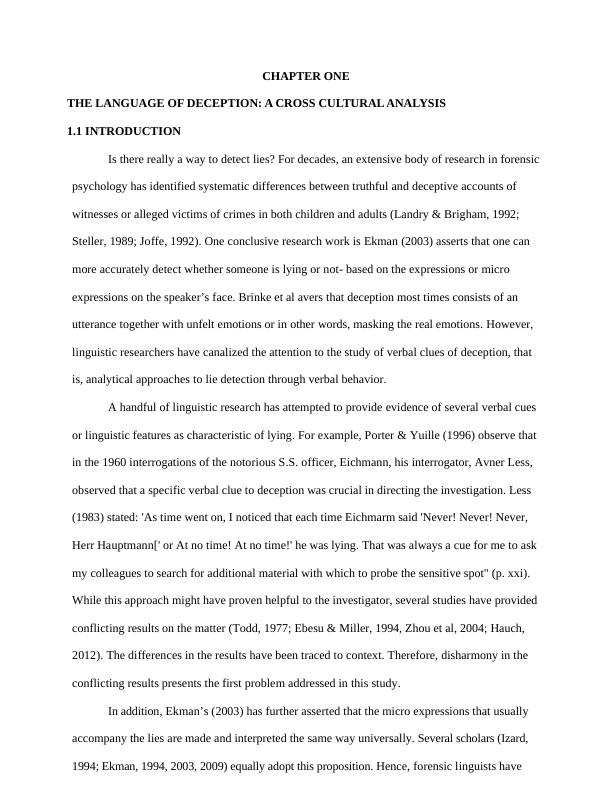
raised eyebrows to discover whether supposed linguistic features of deception are also universal.
This is paramount because if these linguistic features are not the same cross-culturally, law
enforcement personnel and analysts attempting to detect detection in non-native English
speakers may be misidentifying lairs and truth-teller; the inaccuracies could indubitably have
significant consequences, particularly in the lives of the suspects. Therefore, the second problem
presented in this thesis is the question of the universality of linguistic features of deception.
The review of literature reveals that a handful of researches has been conducted and
documented on the language of deception. However, only a few researches have been carried out
on the language and cross-cultural perceptions of deception. The current study addresses these
gaps in the literature by analyzing and comparing truthful and deceptive discourse of a selected
number of native English- speaking British and non-native English-speaking Nigerians. The
discourse done in a one-on-one interview allows for spontaneous answers. These reflect on each
respondent and features questions about individuals. Afterwards, a selected number of native
English-speaking British and non-native English-speaking Nigerians will judge the responses.
This is paramount because if these linguistic features are not the same cross-culturally, law
enforcement personnel and analysts attempting to detect detection in non-native English
speakers may be misidentifying lairs and truth-teller; the inaccuracies could indubitably have
significant consequences, particularly in the lives of the suspects. Therefore, the second problem
presented in this thesis is the question of the universality of linguistic features of deception.
The review of literature reveals that a handful of researches has been conducted and
documented on the language of deception. However, only a few researches have been carried out
on the language and cross-cultural perceptions of deception. The current study addresses these
gaps in the literature by analyzing and comparing truthful and deceptive discourse of a selected
number of native English- speaking British and non-native English-speaking Nigerians. The
discourse done in a one-on-one interview allows for spontaneous answers. These reflect on each
respondent and features questions about individuals. Afterwards, a selected number of native
English-speaking British and non-native English-speaking Nigerians will judge the responses.
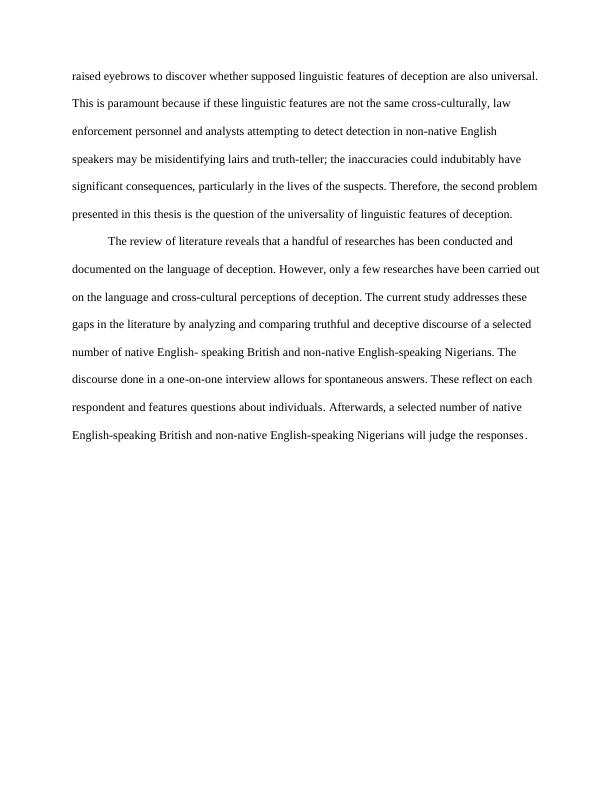
It is pertinent to state here that circumstances presented themselves for the primary
researcher to travel to Nigeria. This provides the researcher firsthand experience and
trustworthy data by eliciting response to the following research questions: (1) In the context of
the experiment (to be conducted), what linguistic features do the British and Nigerians use in
deceptive speech? (2) What linguistic differences are there, if any, between British and
Nigerian baseline speech in the context?
The next chapter provides a review of the literature on the topics of the linguistic
features of deception and cross-cultural perceptions of deception.
researcher to travel to Nigeria. This provides the researcher firsthand experience and
trustworthy data by eliciting response to the following research questions: (1) In the context of
the experiment (to be conducted), what linguistic features do the British and Nigerians use in
deceptive speech? (2) What linguistic differences are there, if any, between British and
Nigerian baseline speech in the context?
The next chapter provides a review of the literature on the topics of the linguistic
features of deception and cross-cultural perceptions of deception.
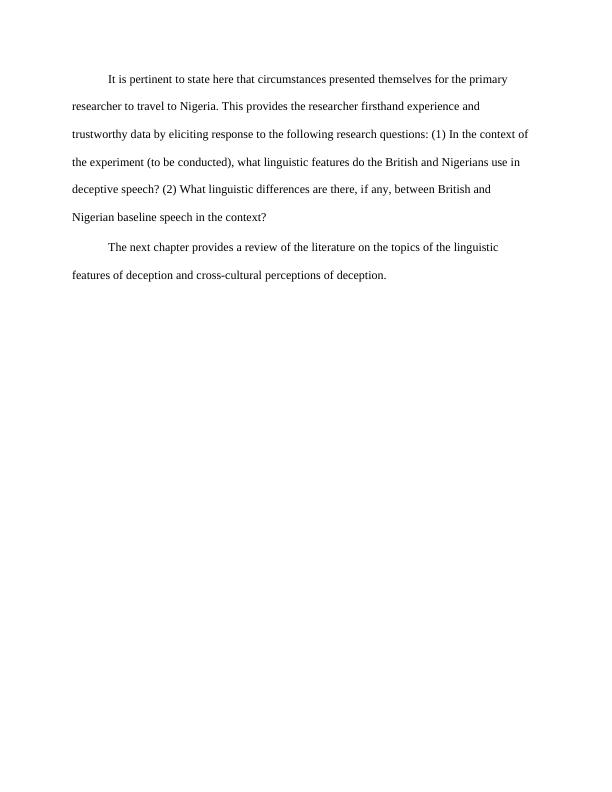
CHAPTER TWO
2.1 Introduction
Humans, lie, deceive and mislead – all forms of deception. The focus of this research is
to attempt the possibility of detecting lies in verbal behavior through an analytical study of the
linguistic features (i.e. word count, word structure, redundancy etc.) of deceitful
communication generally and the cross- cultural detection of deception. It also aims to
elaborate on relevant but underdeveloped concepts of language of deception. This chapter
begins with an examination of the postulated theories of language of deception and a
clarification of the categorization of some linguistic features as characteristics of deception.
Further, this chapter reviews some of the most examined linguistic features of deception. It
looks at how these features aid the detection of deception across-cultures.
2.2 LIE, DECEIT AND DECEPTION
The authors of Theories of Human Communication, Littlejohn and Foss (2005), have
defined deception as the “deliberate manipulation of information, behavior and image in order to
lead another person to a false belief and conclusion” (p.152). Levine (2014) describes deception
as “intentionally, knowingly, and/or purposely misleading another person.” Similarly, deception
has further been defined as the act of intentionally instilling a belief in another that the sender
knows to be false (Vrij, 2008; Ekman & O’Sullivan). Therefore, the definition and description of
deception is generally based on three facts: the act is deliberate or intentional, the sender is aware
that the belief instilled in the other does not match what they know to be true, and its aim is to
mislead. Regardless, McCornack & Parks (1986) argues that deception is a necessary component
of social communication (Knapp, 2006; Ekman, 2005).
2.1 Introduction
Humans, lie, deceive and mislead – all forms of deception. The focus of this research is
to attempt the possibility of detecting lies in verbal behavior through an analytical study of the
linguistic features (i.e. word count, word structure, redundancy etc.) of deceitful
communication generally and the cross- cultural detection of deception. It also aims to
elaborate on relevant but underdeveloped concepts of language of deception. This chapter
begins with an examination of the postulated theories of language of deception and a
clarification of the categorization of some linguistic features as characteristics of deception.
Further, this chapter reviews some of the most examined linguistic features of deception. It
looks at how these features aid the detection of deception across-cultures.
2.2 LIE, DECEIT AND DECEPTION
The authors of Theories of Human Communication, Littlejohn and Foss (2005), have
defined deception as the “deliberate manipulation of information, behavior and image in order to
lead another person to a false belief and conclusion” (p.152). Levine (2014) describes deception
as “intentionally, knowingly, and/or purposely misleading another person.” Similarly, deception
has further been defined as the act of intentionally instilling a belief in another that the sender
knows to be false (Vrij, 2008; Ekman & O’Sullivan). Therefore, the definition and description of
deception is generally based on three facts: the act is deliberate or intentional, the sender is aware
that the belief instilled in the other does not match what they know to be true, and its aim is to
mislead. Regardless, McCornack & Parks (1986) argues that deception is a necessary component
of social communication (Knapp, 2006; Ekman, 2005).
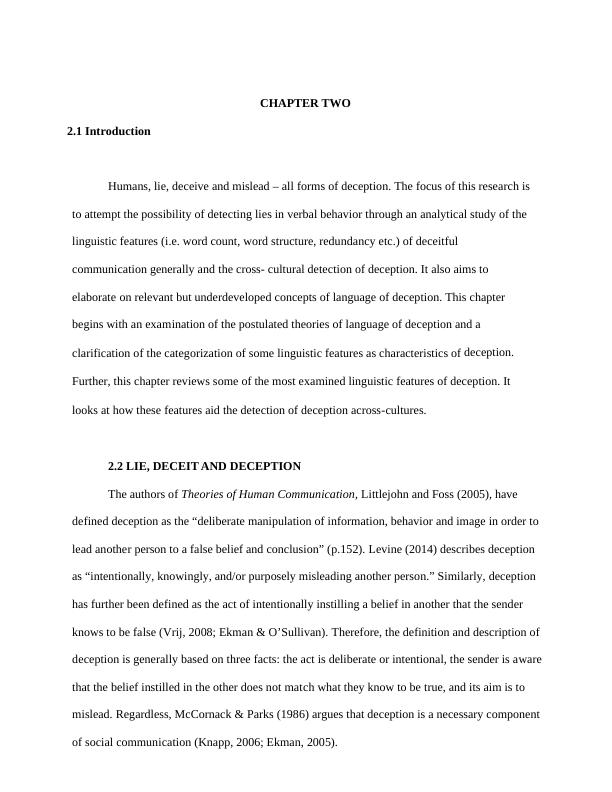
Sapir (1987) admits that “it is very difficult to lie” because liars must construct a
consistent and coherent narrative, repress revealing information that may be incriminating, and
sell this structured deception using proper channels and signals of communication to heighten
their credibility (Zloteanu, 2016). The complexity of such attempt “leaks” verbal and nonverbal
cues of deception such as behavioral control, emotional arousal, verbosity, redundancy, hedges,
etc. An examination of the cues gives insight to investigation in law enforcement, deception
detection research, psychology and forensic linguistics. Therefore, this study aims to analyze the
linguistic features of deception in selected deceptive communication.
Similarly, researchers, law enforcers and social workers have also investigated the
possibility of children lying and the possibility of lying successfully (Talwar, 1999). Steller
(1989) has observed systematic differences between truthful and false accounts of witnesses or
alleged victims, including children. Research has proven that children lie for two main reasons:
to foster interpersonal relationships (e.g. an instance of a child who says she likes a birthday gift
she does not actually like); to gain personal benefits (e.g. stealing a candy and denying it when
asked) (Talwar, 1999). Maggain and Villeval (2015) claim that “older children who become
more concerned about others’ welfare lie less than younger ones.” The rationale behind this
assertion is that older children need justification to lie. Evidently, researchers unanimously
agree that children (and teenagers) possess deceptive verbal and non-verbal behaviors.
However, the ability and possibility of children (teenagers) detecting deception in
communication among themselves remains a vacuum in deception research. The current study
therefore investigates teenagers ability to deceive and detect deception. This research direction
has implications for assessing the credibility of child witness testimony ( Honts, 1994).
consistent and coherent narrative, repress revealing information that may be incriminating, and
sell this structured deception using proper channels and signals of communication to heighten
their credibility (Zloteanu, 2016). The complexity of such attempt “leaks” verbal and nonverbal
cues of deception such as behavioral control, emotional arousal, verbosity, redundancy, hedges,
etc. An examination of the cues gives insight to investigation in law enforcement, deception
detection research, psychology and forensic linguistics. Therefore, this study aims to analyze the
linguistic features of deception in selected deceptive communication.
Similarly, researchers, law enforcers and social workers have also investigated the
possibility of children lying and the possibility of lying successfully (Talwar, 1999). Steller
(1989) has observed systematic differences between truthful and false accounts of witnesses or
alleged victims, including children. Research has proven that children lie for two main reasons:
to foster interpersonal relationships (e.g. an instance of a child who says she likes a birthday gift
she does not actually like); to gain personal benefits (e.g. stealing a candy and denying it when
asked) (Talwar, 1999). Maggain and Villeval (2015) claim that “older children who become
more concerned about others’ welfare lie less than younger ones.” The rationale behind this
assertion is that older children need justification to lie. Evidently, researchers unanimously
agree that children (and teenagers) possess deceptive verbal and non-verbal behaviors.
However, the ability and possibility of children (teenagers) detecting deception in
communication among themselves remains a vacuum in deception research. The current study
therefore investigates teenagers ability to deceive and detect deception. This research direction
has implications for assessing the credibility of child witness testimony ( Honts, 1994).
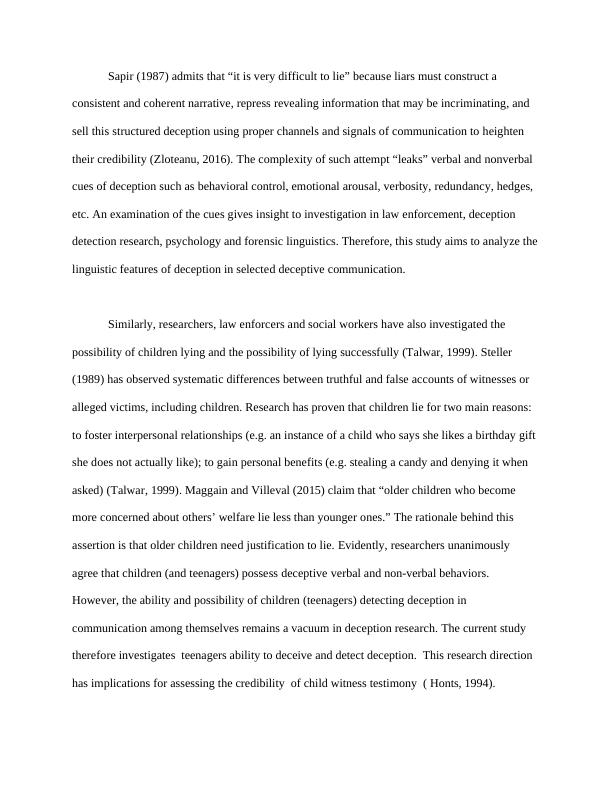
End of preview
Want to access all the pages? Upload your documents or become a member.
Related Documents
Power in Courtroom Discourse: Direct-Examination and Cross-Examination Questioninglg...
|43
|13259
|77
